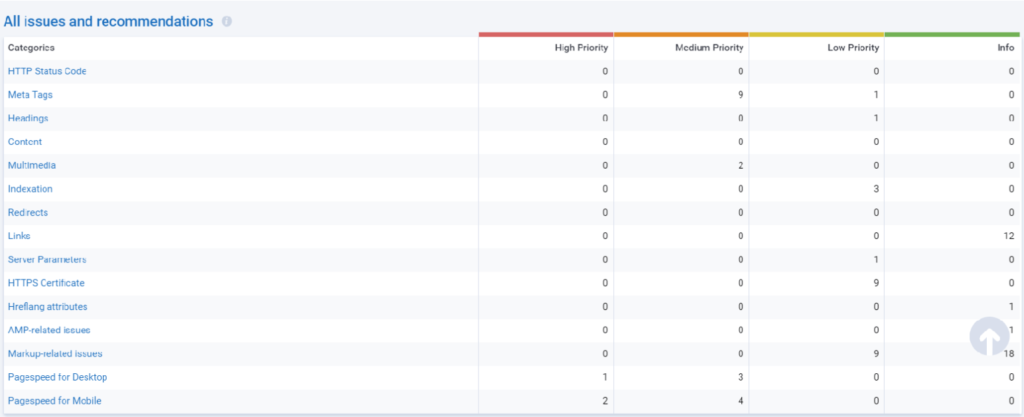What is a website audit?
A website audit helps to identify the strong and weak sides of your website from three perspectives:
- Yours own
- Search engines’
- Customers’
While performing a website audit, the following parameters are evaluated:
- Design, user experience, and engagement
- Traffic and website performance
- On-page and off-page SEO
- Technical aspects
- Content
By analyzing these parameters, you will get a better understanding of whether your website is moving in the right direction or not. This will help you know what you must change and improve, as well as how to adjust your strategy. Here is an example of a website audit.
Why perform a website audit
Performing a website audit is essential, because not tracking your failures and successes makes it impossible to reach your target goals.
A website audit is conducted to identify a broad spectrum of issues on your website, eliminate them, and improve performance. The process helps you understand if your website is correctly optimized for search engines and if it has great content and a user-friendly design.
It is essential to perform audits regularly in order to notice, over time, if something is going wrong. Website developments, as well as SEO, are continuous activities. You must know where you are right now in order to adjust your strategy for future improvements. Doing so helps you remain as effective as possible and promptly react if conversation or traffic decreases.
How to conduct a website audit
This is a broad topic with no simple answer. Nevertheless, to make a process of performing a website audit easier for you, we’ve outlined the main steps and shared some advanced tools to help you along the way.
Technical errors
Technical errors are the most common issues detected during an audit. There is a need to fix them to improve SEO or to make your website more user-friendly.
The most convenient way to check your website for technical issues is to use site auditor tools.
If you don’t have a large website with thousands of pages, you can check it manually as well. The most frequent issues include:
- HTTPs Status – In 2021, it’s essential to use an encrypted connection. Moreover, it’s one of Google’s ranking factors. However, even if you already have the SSL certificate, there may still be issues with the HTTPs status. For instance, internal links to non-HTTPs version of pages or some content loaded using HTTP.
- PageSpeed – According to Neil Patel, if your site takes more than three seconds to load, you lose 75% of your potential readers. You can check your site’s loading speed using the Google PageSpeed tool.
- Broken Images and Links – These features decrease your site’s ranking and user-friendliness. Broken images and links cause visitors to leave your website within seconds, which sends a signal to the search engines. As a result, your ranking worsens because your website is seen as not valuable to users.
- XML Sitemap Status and Robots.txt File – The Robots.txt file tells the search engine which pages to crawl, while the XML sitemap shows the structure of your website. If your website is less than 10 pages, these files are not very important.
- Mobile-Friendliness – This feature improves user experience and may affect your site’s ranking.
SEO
Search engine optimization is an important part of website development, which consists of:
- On-Page SEO – Factors you can affect directly, such as keywords and content.
- Off-Page SEO – Factors that come from outside of the website, such as social media signals, link building, collaborations with influencers, etc.
We’ve composed a short guide on how to perform an SEO audit.
On-page SEO
Much like technical issues, you can easily improve on-page SEO as you are in control of this aspect of the website. According to Brian Dean, there are 200 ranking factors (though a lot of them are still unproven). We’ve collected the most important of these for you below:
- Keep in mind SEO keywords and their placement. Every page on your website should have a target keyword within the first 100 words. This will highlight the focus of your article for the search engine.
- Meta descriptions aren’t going to affect your ranking dramatically, but an engaging and compelling description is important to help users understand whether they will find the information they need on your website.
- Title tags and page titles help search engines understand what your webpage is about. These will be displayed on the SERPs (Search Engine Results Page). The more relevant and exact your titles are, the more traffic from search engines you will generate.
- Duplicate pages with shallow content are seen as unhelpful by many search engines.
Off-page SEO
Off-page SEO is one of the most important and challenging parts of website optimization. You only have indirect control over most off-page SEO factors. Nowadays, it’s much easier to audit the off-page SEO side of your website. There are many tools from different companies, including Google that aiming to help you follow your metrics and different indicators, which may affect your ranking.
It is necessary to track backlinks to your website, including the quality, quantity, and relevance of said links. As soon as you notice any bad backlink, you should disavow it using the Google Disavow tool. Your backlink portfolio should be growing every week. Otherwise, you should search for area to improve in your off-page SEO strategy.
There is also a need to track your user activities on social media. The ideal scenario is that you have engaging content, which grows your traffic and shares on social media. Sure, it’s not only about the content. You also have to work with influencers and track your progress in this field as well.
User experience
Improving user experience is crucial to achieving success in the optimization and promotion of your website. This part of the audit is hard to evaluate. But, in general, you must check how fast your webpages are and how simple it is to navigate your website. Also, you must analyze if there are any elements that may be blocked, such as pop-up advertisements.
There could be many more problems that affect the user experience. Thus, track how people are interacting with your website by using helpful tools like Hotjar and other heat map tools.
If there are any pages where most people spent just a few seconds, there is likely a problem. Such analysis helps you recognize and fix problems in the early stages.
Content
Quality content is the most valuable asset you have on your website. It helps you retain existing users and attract new ones. While conducting an audit, you must check your content and improve it if necessary. There are plenty of tools to help you check the quality of your content:
Of course, you can check the length of articles and other parameters using these tools. However, automatic tools can’t check your articles with the same level of detail that you can by doing it manually, especially in terms of meaning and relevance to the topic.
Note: Too long and too short articles may be considered less valuable by both users and search engines. However, there is no universal length that suits everyone. The basic barometer is that the article must cover the reader’s questions.
To create really engaging content, you should use pictures and other visual elements as well as social sharing buttons.
Design
If you have a terrible design, most users will never come back. Compose your website in a way that helps users focus on the content. All advertisements must be integrated naturally, so as not to bother users as they consume the content.
During a website audit, it is important to check if all the details are composed in the right way for your readers. Among the most frequent mistakes are:
- Too small or informal fonts
- The wrong color combination and low contrast
- Annoying advertisements, especially those that cover content
Website audit checklist
Basically, the website audit checklist depends on what aims you have, but there will always be five main parts:
- Technical Issues
- SEO
- User Experience
- Content
- Design
You may conduct every part of the audit manually or using specific tools. If you have a large website, you should use automated tools to avoid spending an eternity on the audit. If you have a small website, you may perform the audit manually. You may create your own website audit template and fill it out as you go to track your progress.
Website audit example
You may conduct an audit manually or using specific tools, according to your needs and size of your website. We choose SerpStat.com, because there is a possibility to audit the website for free without authorization (only once though). So, we decided to check the website: Travelblog.org.
After the audit, the tool will generate a summary, where you can see all the issues with the website. All issues will be categorized by priority, so you may plan your work in the right order:

By clicking on a certain issue, you can see a detailed description and recommendation on how to fix it:

Best website audit tools
When choosing a website audit tool, you must consider what exactly you need. Every tool is focused on a different field. If you are searching for a tool to optimize user experience, then you might want to choose Hotjar.
If you want a simple, free tool, HubSpot Website Grader may be your ideal choice. As a complex solution, you may choose RAVEN Site Auditor, WebCEO Site Auditor, or Serpstat.
If you are thinking of performing a website competitor analysis, you may want to use SEMRush Site Auditor.
| Name | Price | Features |
| HubSpot Website Grader | Free | Basic tool to quickly check your website |
| Hotjar | 15-Day Free Trail$89-389/month | One domain Visitor Recordings – helps to understand their behavior Heat Maps – helps to understand what sections of the page are the most popular |
| Google Search Control | Free | Shows errors on the pages Helps to monitor search performance |
| Serpstat | $69-499/month | Unlimited number of domains Complex audit with a website audit report that lists the detected issues and provides recommendations on how to fix them |
| RAVEN Site Auditor | $39-399/month | From 2 to 320 domains Can audit 150,000 to 2,500,000 pages Complex auditKPI tracking |
| SEMRush Site Auditor | $99.95-399.95/month | From 3 to 25 domains Up to 20,000 pages to audit Complex analysis Comparison with competitors’ websites |
| WebCEO Site Auditor | 14-Day Free Trial$99-299/month | From 1 to 30 domains Can audit 100 to 150,000 pages Complex audit, including media activity |
How to easily perform a website audit
If you want to develop your website successfully, you must perform an audit in the beginning and regularly repeat the process. It is difficult to imagine regular audits without using a website auditing software.
The best way to find the right one for you is to test a few tools and choose one, or a few, that suits your needs 100%. However, a truly high-quality website audit is only possible by combining automatic tools with manually checking.




